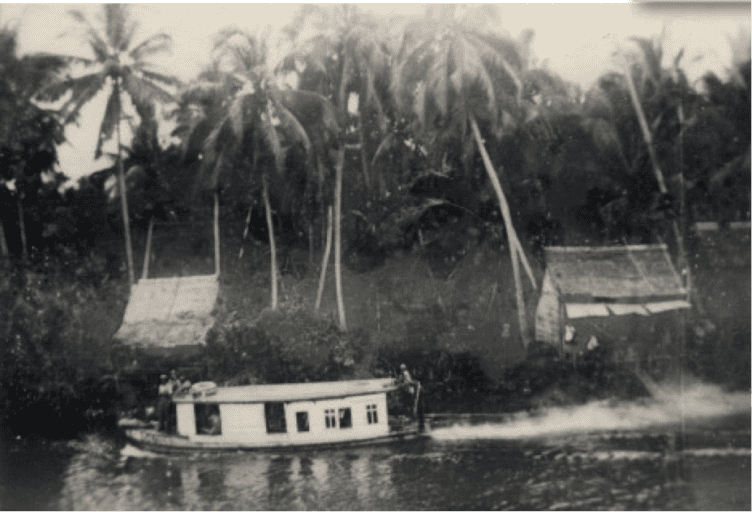- With funding from the National Geographic Society we are retracing the footsteps of Henry Cushier Raven, a specimen collector who travelled extensively in East Kalimantan, Indonesia between 1912 and 1914.
- We want to know which species Raven found and whether we can still find these species today.
- In April 2016, we already covered the Berau and East Kutai parts of Raven’s journey. This is the story of his Mahakam travels.
- The story is published in four parts. This is part 1.
Samarinda, East Kalimantan, Indonesia – 13 November 2016.
We drive to Samarinda, the riverside capital of East Kalimantan Province in Indonesian Borneo, on a cloudy but warm day. Our boat, which Rustam our local wildlife expert has arranged, is waiting at the pier. There are some delays. Someone has thrown a Molotov cocktail at a local church, killing one young child and wounding several others. He tries to escape but locals catch him when he tries to flee into the river, and things do not end well. Religious tensions are once again playing up in Indonesia and the town is in turmoil so we are keen to get out sooner rather than later. The boat owner, however, has different thoughts and first wants to renegotiate the price that we had agreed for his boat. We step back and let Rustam take charge. After half an hour of bargaining we are good to go. Rustam sticks to his guns and doesn’t budge on the initial price. We push off and our journey in Raven’s footsteps can begin.

With financial support from the National Geographic Society, our team is retracing the route followed by Henry Cushier Raven just over 100 years ago. Raven worked as a specimen collector for the Smithsonian in Washington. Between January 1912 and November 1914 he travelled extensively through what was then Dutch East Borneo to collect nearly 2,500 mammal, bird, and reptile specimens, now housed in the Smithsonian National Museum of Natural History in Washington DC. When I came across Raven’s diaries in which he described his travels and collection efforts in great detail, I realized that this was a unique opportunity to assess how Borneo’s nature and wildlife had changed over the past century.
Raven started off on June 1st 1912 from exactly the same location as us. He convinced the Sultan of Tenggarong, a town further upriver, to let him use his steam launch, and the boat Raven used would have not have been that different from the one we are currently on, although he travelled on coal and we run on gasoline. Raven first stopped in the small forest town of Loa Buah and stayed there for 2 weeks. He collected several species that will now be impossible to find here because all the forest is gone. This included the Bornean banteng, a species of wild cattle that has nearly been hunted to extinction, and is unlikely to be found within 300 miles of our current location. In fact, I have only once seen banteng on Borneo in my 20 years of surveys here, and that was in a very remote grassland location deep in the island’s interior.


Raven also collected the elusive Bornean bay cat and Müller’s gibbon, a primate of tall jungle. Neither of these are likely to occur in the logged over, scrubby bush through which our boat is currently gliding. The entire area has now been turned into a massive coal mining site, with coal being loaded on hundreds of humongous coal barges that line the Mahakam’s banks. Nevertheless, even in Raven’s times much of the land around the Mahakam was already cultivated and he wrote that “no original forest remains, except in the swamps”. It might well be that Raven saw the landscape pretty much how I see it now, at least in this densely populated part of the country. What has changed are the many coal mines and probably the much increased hunting pressure. A lot of Borneo’s species could survive in this landscape if it wasn’t for the severe hunting for food (mostly deer, pigs and wild cattle), medicinal uses (pangolins and hornbills), or for pets (the thriving bird and reptile trade).

Several factors are driving this increased human pressure. There are far more people in this province now than 100 years ago – ca. 150,000 in 1912 versus some 4 million in 2015. Where Raven mentioned occasional villages, we now see an almost uninterrupted band of houses lining the river. Also, access has much improved with roads, air planes and boats now connecting Borneo’s interior to the vast national and international markets for its products.
We are now entering the flatlands were swamp forests “stretched as far as the eye can see” in Raven’s time. This is where another scourge of Borneo’s lowland wildlife becomes apparent: The oil palm. Much of the lowland area here has been given out for the development of this high-yielding oil crop, and few species are able to survive in the vast palm monocultures.
Typical birds are now missing from the landscape. I have been up and down this river many times since the early 1990s when I first surveyed the area. Still, I am surprised to see that once common birds that I would definitely see on each river trip now seem to be absent. The Brahminy kite, a riverine hawk, is one of these. It won’t be until much further upriver when we see the first of these birds. What is reducing their populations is unclear.
Other missing birds are the Oriental darters, the snake-necked cormorants normally common along these rivers. Fishermen don’t like them because they compete for the same, increasing sparse freshwater fish resources. Mammals are also scarce. It takes pretty much the entire first day of our trip before we see the first one, a lone long-tailed macaque sitting in one of the few remaining trees.


Part I of IV. PART II
Erik Meijaard coordinates the Borneo Futures initiative. Follow @emeijaard and @borneofutures.
Header image: Adult male orangutan in Kalimantan. Photo by Rhett A. Butler.
